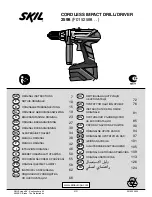
8 ENGLISH
Lighting up the front lamp
►
Fig.4:
1.
Lamp
CAUTION:
Do not look in the light or see the
source of light directly.
Pull the switch trigger to light up the lamp. The lamp
keeps on lighting while the switch trigger is being pulled.
The lamp goes out approximately 10 seconds after
releasing the switch trigger.
NOTE:
Use a dry cloth to wipe the dirt off the lens of
the lamp. Be careful not to scratch the lens of lamp, or
it may lower the illumination.
Reversing switch action
►
Fig.5:
1.
Reversing switch lever
CAUTION:
Always check the direction of
rotation before operation.
CAUTION:
Use the reversing switch only after
the tool comes to a complete stop.
Changing the
direction of rotation before the tool stops may dam
-
age the tool.
CAUTION:
When not operating the tool,
always set the reversing switch lever to the neu
-
tral position.
This tool has a reversing switch to change the direction
of rotation. Depress the reversing switch lever from the
A side for clockwise rotation or from the B side for coun
-
terclockwise rotation.
When the reversing switch lever is in the neutral posi-
tion, the switch trigger cannot be pulled.
Speed change
►
Fig.6:
1.
Speed change lever
CAUTION:
Always set the speed change lever
fully to the correct position.
If you operate the
tool with the speed change lever positioned halfway
between the "1" side and "2" side, the tool may be
damaged.
CAUTION:
Do not use the speed change lever
while the tool is running.
The tool may be damaged.
Position of
speed
change lever
Speed
Torque
Applicable
operation
1
Low
High
Heavy load
-
ing operation
2
High
Low
Light loading
operation
To change the speed, switch off the tool first. Select
the "2" side for high speed or "1" for low speed but high
torque. Be sure that the speed change lever is set to the
correct position before operation.
If the tool speed is coming down extremely during the
operation with "2", slide the lever to the "1" and restart
the operation.
Adjusting the fastening torque
►
Fig.7:
1.
Adjusting ring
2.
Graduation
3.
Arrow
The fastening torque can be adjusted in 21 levels by turning the adjusting ring. Align the graduations with the arrow
on the tool body. You can get the minimum fastening torque at 1 and maximum torque at
marking.
The clutch will slip at various torque levels when set at the number 1 to 20. The clutch does not work at
the
marking.
Before actual operation, drive a trial screw into your material or a piece of duplicate material to determine which
torque level is required for a particular application.
The following shows the rough guide of the relationship between the screw size and graduation.
Graduation
1
2
3
4
5
6
7
8
9
10 11 12 13 14 15 16
17
18 19 20
Machine screw
M4
M5
M6
Wood
screw
Soft wood
(e.g. pine)
–
ɸ
3.5 x 22
ɸ
4.1 x 38
Hard wood
(e.g. lauan)
–
ɸ
3.5 x 22
–
–
ɸ
4.1 x 38









































